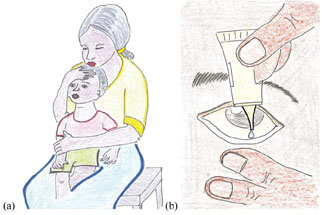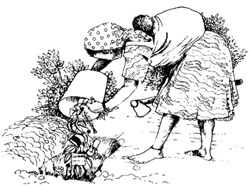Prevention and control of trachoma
There are four major components for the prevention and control of trachoma at community level, which are represented by the letters SAFE (see box and the details below).
SAFE strategy for the prevention and control of trachoma
S = Surgical treatment for trichiasis to stop eyelashes rubbing the cornea
A = Antibiotic treatment of active cases of trachoma by tetracycline 1% ointment applied to the eyes
F = Faces and hands washed regularly to prevent infection spreading
E = Environmental sanitation and safe water supply.
Surgical treatment
A simple surgical procedure can save a patient from becoming blind. Surgery can be carried out at a higher health facility by trained nurses and may simply involve turning out the eyelashes that are scarring the cornea. Your role is to reassure and refer patients with Grades 3 to 5 (i.e. trachomatous scarring, trachomatous trichiasis, or corneal opacity) for immediate surgery. Explain that the operation is very simple, quick and safe, and it will greatly reduce the discomfort in their eyes and prevent further damage from occurring.
Antibiotic treatment
You are expected to treat grade 1 and grade 2 active trachoma (i.e. people with trachomatous follicles and trachomatous inflammation in at least one eye) in the community. You should show parents how to administer tetracycline 1% ointment onto the conjunctiva inside the eyelids twice every day for six weeks (figure a and b, below). If you identify two or more family members with trachoma, treat the whole family.

If you are informed that trachoma is a major concern, you may be advised to treat all the children in your community as a preventive measure. If this is the case, treat all children with tetracycline eye ointment for five consecutive days in a month, and repeat the same procedure for six consecutive months. Alternatively, a doctor may prescribe the oral antibiotic azithromycine (20 mg/kg bodyweight) as a single dose in place of tetracycline to treat the whole community.
Face washing
Educate all families, particularly mothers of children (figure below), by going house to house to teach them the importance of regular washing of face and hands, ideally using soap. Go to schools to teach children there in a large group that washing regularly prevents the transmission of trachoma from person to person. Everyone should learn the habit of washing their hands with soap and water in the early morning before they touch their eyes, before and after eating or preparing food, and after using the latrine.

Environmental sanitation
Educate every family to dispose of their household rubbish in a pit dug away from their home (figure below). Garbage and other dirty materials can be buried using spades or other locally made tools. The waste materials should be covered with soil or burnt inside the pit. Educate adults and children to keep their surrounding environment clean and free from rubbish and animal dung, to avoid encouraging the breeding of flies. Animals should be penned away from the house at night. Encourage everyone to use latrines and a safe water supply to prevent disease transmission by flies and dirty hands. Latrines should be properly covered after use.

Now read the following Case Study and then answer the question that follows it.
Case Study. Mrs Halima asks about her child's eye problems
Mrs Halima lives in a remote rural village. Her ten-year-old son has had eye discharges for the last three years, which seem to be getting worse. During the last one year, his eyes frequently weep tears and look swollen and red, and the boy complains that his eyes are sore. Mrs Halima has taken him to several traditional healers, but his eye problems have not been cured. She tells you she believes that her child's eye problems are related to supernatural powers and no treatment can help him.
What do you advise Mrs Halima and what action do you take for the child?
Explain to the mother that her son's eye problems are a disease called trachoma, caused by bacteria. Tell her it can be cured using medicine in the eyes or a very simple operation to stop the child's eyelashes turning inwards and rubbing his eyes. Examine the boy's eyes and decide what grade of trachoma the disease has reached. If the grade is TF or TF+TI, treat him with tetracycline eye ointment (1%), and show the mother how to do it twice a day for the next six weeks. Follow up his progress regularly every week. If the boy needs surgery, inform the mother and refer him to the nearby higher health facility immediately.